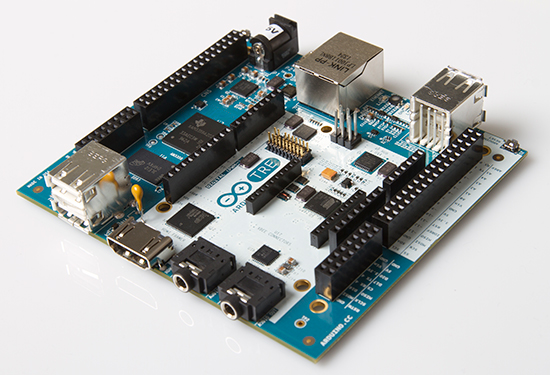03
A sneak preview of Arduino TRE powered by Texas Instruments
Announcements, ArduinoTre, Linux, MakerFaire, Massimo Banzi, Sitara, Texas Instruments, TRE Comments Off on A sneak preview of Arduino TRE powered by Texas Instruments
Next saturday 5th of October Massimo Banzi with Jason Kridner and Gerald Coley (Texas Instrument) will talk about the new collaboration on Arduino TRE during a talk at Maker Faire Rome ( from 15.30 in Room G – Archimede).
Arduino TRE, based on the Texas Instruments Sitara AM335x ARM Cortex-A8 processor is the “most powerful Arduino to date” and the first that will be able to run “full Linux.”
Thanks to the 1-GHz Sitara AM335x processor, Arduino developers get up to 100 times more performance with the Sitara-processor-based TRE than they do on the Arduino Leonardo or Uno. This performance opens the doors to more advanced Linux-powered applications. The Sitara-processor-based Linux Arduino can run high-performance desktop applications, processing-intensive algorithms or high-speed communications.
The Arduino TRE is two Arduinos in one: the Sitara-processor-based Linux Arduino plus a full AVR-based Arduino, while leveraging the simplicity of the Arduino software experience. The integration of the AVR Arduino enables the Arduino TRE to use the existing shield ecosystem so that innovators can expand the Arduino TRE to develop a wide range of high-performance applications such as 3D printers, gateways for building automation and lighting automation, telemetry hubs that collect data from nearby sensors wirelessly, and other connected applications that require host control plus real-time operations.
In addition, the Arduino TRE is partially the result of a close collaboration between Arduino and the BeagleBoard.org foundation. These open hardware pioneers share a passion for expanding open source development and making technology accessible for artists, designers and hobbyists. The TRE design builds upon the experience of both Arduino and BeagleBoard, combining the benefits of both community based boards.
“By choosing TI’s Sitara AM335x processor to power the Arduino TRE, we’re enabling customers to leverage the capabilities of an exponentially faster processor running full Linux,” said Massimo Banzi, co-founder, Arduino.
“Our customers now have a scalable portfolio at their fingertips, from the microcontroller-based Uno to the TRE Linux computer.”
The Arduino TRE is expected to be available in spring 2014 but you’ll be able to see it live during Maker Faire Rome.
See more pictures of Arduino TRE on Flickr.












